Text_Typology文本类型_赖斯
Text typology in news translation

主要作品:
Translation Criticism: The Potentials & Criticism 《翻译批评:潜力与制约》 Type, Kind and Individuality of Text---Decision making in translation 《 翻译的抉择: 类型、体裁及文本的个性》
Text typology
信息功能文本(informative text):给读者传递 真实世界中的事物和现象。如果原文文本和译文文本 都属于信息文本,在翻译过程中,译者应该准确、完 整地再现原文的内容。就风格选择而言,则应以目的 语文化的主导规范为指导。该类文本包括:新闻、商 业信件、货物清单、说明书、专利说明、论文、报告、 以及人文社会科学、自然学科和其它技术领域的所有 文献。 文本翻译:译文应充分传达原文的指涉功能,文本中指 涉的可能是现实的或者虚拟的事物。
Text typology
以内容为中心的文本 content-focused 批评者要确信:内容和信息在目的语中能够完全再现 以形式为中心的文本 form-focused 在译文中是否取得相等同的审美效果 以呼吁为中心的文本
信息功能文本
表情功能文本
appeal-focused
操作功能文本
译文是否达到与原文等同的效果,是否感染听者,打动读者
Company Logo
Katharina Reiss 个人简介:
1923年出生于德国,是著名的翻译理论家,精通德语ห้องสมุดไป่ตู้西班牙语。 先后执教于海德堡大学、维尔茨堡大学和美因茨大学,长期在大学从 事翻译研究和教学。
贡献:
将功能对等理论应用到翻译批评中,提出比较合理的翻译批评 观,以功能等值作为译文质量评估标准。 70年代初首先提出,等值的概念不应该只停留在字、词、句的 微观层面上,而应该涉及文本(语篇层面)。
德国功能翻译理论

德国功能翻译理论苏珊·巴斯内特和安德烈·勒菲弗尔(2001:l)认为,西方翻译研究发展史的显着特点之一就是对等,这一曾经至关重要的概念,逐渐淡化,并最终消解。
20世纪70年代后期,随着经济全球化的发展,翻译活动更加频繁,各种文本类型的翻译需求迅速增加,非文学文本成为翻译研究的重要考察对象,德国功能翻译学派应运而生。
这个学派的主要代表人物是:卡塔琳娜·赖斯(Katharina Reiss)、汉斯·弗米尔(Hans J. Vermeer)、贾斯特·赫尔兹-曼塔利(Justa Holz-M?ntt?ri)和克里斯蒂安·诺德(Christiane Nord)。
德国功能翻译学派为翻译理论研究提供了崭新的视角,其代表理论有:的功能主义翻译批评理论(functional category of translation criticism),即文本类型理论(text typology);弗米尔的目的论(skopos theory);赫尔兹-曼塔利的翻译行为理论(theory of translation action)和诺德的功能加忠诚理论(function plus loyalty)。
由于多元体系翻译观的影响,与原文文本至高无上观念紧密相关的等值标准逐步被侧重目标系统(target system)的观念所取代。
1.2.1功能翻译学派的理论基础卡尔·布勒于1934年提出了语言功能“工具模式”,对功能翻译理论有深远的影响,为赖斯的文本类型学和弗米尔的目的论奠定了基础。
1.2.1.1布勒的语言功能工具模式布勒的语言功能“工具模式”包含以下组成因素:语境(context):语言的“表现功能”,涉及符号与世界的关系;说话者(speaker):语言的“表达功能”,涉及符号和说话者的关系;受话者(hearer):语言的“感染功能”,涉及符号与受话者的关系;符号(sign)。
翻译术语(理论笔译)

Absolute translation 绝对翻译古阿德克(Gouadec)Abstract translation 摘要翻译古阿德克(Gouadec)Abusive translation 滥译路易斯(Lewis)Acceptability 可接受性托利(Toury)Accuracy 准确Adaptation 改编Adequacy 充分性Adjustment 调整Analogical form 类同形式霍尔姆斯(Holmes)Analysis 分析奈达(Nida)和泰伯(Taber)Applied translation studies 应用翻译研究霍尔姆斯(Holmes) Architranseme (ATR)元译素范·路文兹瓦特(van Leuven-Zwart) Autonomy Spectrum 自立幅度罗斯(Rose)Autotranslation 自译波波维奇(Popovic)Back translation 回译Class shift 词类转换韩礼德(Halliday)Close translation 贴近翻译纽马克(Newmark)Communicative translation 传意翻译;交际翻译纽马克(Newmark) Community interpreting 社群传译Compensation 补偿赫维(Hervey)Competence 能力托利(Toury)Componential analysis 语义成分分析奈达(Nida) Comprehensive theory 综合理论Conference interpreting 会议传译Consecutive interpreting 接续传译Contextual consistency 语境一致奈达(Nida)和泰伯(Taber) Conventions 常规诺德(Nord)Corpora 语料库Correspondence 对应Court interpreting 法庭传译Covert translation 隐型翻译豪斯(House)]Creative transposition 创造性移位雅可布逊Creative treason 创造性叛逆罗伯特·埃斯卡皮(Robert Escarpi) Deconstruction 解构主义德里达(Derrida)Descriptive translation studies 描写性翻译研究霍尔姆斯(Holmes) Diagrammatic translation 图表翻译古阿德克(Gouadec)Differance 分延德里达(Derrida)Documentary translation 文献型翻译诺德(Nord)Domesticating translation 归化翻译韦努狄(Venuti)Dynamic equivalence 动态对等奈达(Nida)Dynamic fidelity 动态忠信比克曼(Beekman)与卡洛(Callow) Effort models 用功模式贾尔(Gile)Equivalence 对等Excluded receiver 非目标接受者皮姆(Pym)Exegetic translation 诠释性翻译赫维(Hervey)和希金斯(Higgins)Exoticism 异国情调赫维(Hervey)和希金斯(Higgins)Expectancy norms 期待规范切斯特曼(Chesterman)Explicitation 明示维纳(Vinay)和达尔贝勒纳(Darbelnet)Expressive text 表情型文本赖斯(Reiss)Extraneous form 外来形式霍尔姆斯(Holmes)Faithfulness 忠实Foreignizing translation 异化翻译韦努狄(Venuti)Formal corresponding 形式对应卡特福德(Catford)Formal equivalence 形式对等奈达(Nida)Free translation [sense-for-sense translation 意对意翻译] {literal translation 字面翻译;word-for-word translation词对词翻译} 自由译Full translation 全文翻译General theories of translation 普通翻译理论霍尔姆斯(Holmes)Gist translation 要旨翻译赫维(Hervey)和希金斯(Higgins)Gloss translation 释词翻译奈达(Nida)Grammatical transposition 语法置换赫维(Hervey)和希金斯(Higgins)Hermeneutic motion 诠释步骤斯坦纳(Steiner)Hierarchy of Correspondences 对应层级霍尔姆斯(Holmes)Horizontal translation 横向翻译福勒纳(Folena)Hyperinformation 超额信息赖斯(Reiss)和弗米尔(Vermeer)Idiomatic translation 地道翻译比克曼(Beekman)与卡洛(Callow)Imitation 拟译 1.德莱顿(Dryden)2.利弗威尔(Lefevere)Indeterminacy 不确定性Information offer 信息提供弗米尔(Vermeer)Informative texts 信息文本赖斯(Reiss)Initial norms 初始规范托利(Toury)Instrumental translation 工具翻译诺德(Nord)Integral translation 整合翻译范·路文兹瓦特(van Leuven-Zwart)Interlineal translation 隔行翻译{free translation} 赫维(Hervey)和希金斯(Higgins)Interlinear translation 逐行翻译Interlingual translation 语际翻译雅可布逊(Jacobson)Intersemiotic translation 符际翻译雅可布逊(Jacobson)Intralingual translation 语内翻译雅可布逊(Jacobson)Intra-system shift 系统内转换卡特福德(Catford)Inverse translation 逆向翻译Kernel sentence 核心句Keyword translation 关键词翻译古阿德克(Gouadec)Level shift 层次转换卡特福德(Catford)Lexical translation 词汇翻译卡特福德(Catford)Liaison interpreting[Bilateral interpreting 双边传译] 联络传译凯斯(Keith)Linguistic translation 语言翻译Literal translation 字面翻译;直译Mapping 图谱霍尔姆斯(Holmes)Matricial norms 矩阵规范托利(Toury)Meta-language 元语言霍尔姆斯(Holmes)Metatext 元文本Mimetic form 模仿形式霍尔姆斯(Holmes)Mutation 变异范·路文兹瓦特(van Leuven-Zwart)Naturalness 自然性Negative shift 负面转换Norms 规范Obligatory equivalents 必要对等语奈达(Nida)Oblique translation 曲径翻译维纳(Vinay)和达尔贝勒纳(Darbelnet) Operational model 操作模式巴斯盖特(Bathgate)Operational norms 操作规范托利(Toury)Optional equivalents 可换对等语奈达(Nida)Overlapping translation 重合翻译赫维(Hervey)和希金斯(Higgins)Overt translation 显型翻译豪斯(House)Overtranslation 超额翻译维纳(Vinay)和达尔贝勒纳(Darbelnet) Paradigmatic equivalence 范式对等波波维奇(Popovic)Paraphrase 释译德莱顿(Dryden)Partial theories of translation 局部翻译理论霍尔姆斯(Holmes)Participative receiver 参与型接受者皮姆(Pym)Particularizing translation 具体化翻译赫维(Hervey)和希金斯(Higgins) Performance 运用托利(Toury)Phonemic translation 音素翻译利弗威尔(Lefevere)Phonological translation 音位翻译卡特福德(Catford)Pivot language 中枢语言Polysystem theory 多元文化理论埃文·佐哈尔(Even-Zohar)Pragmatic translation[pragmatic approach语用途径] 语用翻译Preliminary norms 预先规范托利(Toury)Prescriptive translation studies 规定翻译研究托利(Toury)Primary translation 首级翻译迪勒(Diller)和康纳留斯(Kornelius)Problem-restricted theories of translation 关于问题的翻译理论霍尔姆斯(Holmes) Process-oriented translation theories 过程取向翻译研究霍尔姆斯(Holmes) Product-oriented translation studies 成品取向翻译研究霍尔姆斯(Holmes) Professional norms 翻译规范切斯特曼(Chesterman)Prospective translation 前瞻式翻译波斯特盖特(Postgate)Prototext 原型文本波波维奇(Popovic)Pseudotranslation 伪翻译Pure language[Logos 逻各斯] 纯语言沃尔特·本雅明(Walter Benjamin) Radical translation 原始翻译奎因(Quine)Rank-bound translation 级阶受限翻译卡特福德(Catford)Realia 独有特征弗拉科夫(Vlakhov)和弗罗林(Florin)Receptor language 接受语奈达(Nida)和泰伯(Taber)Translation with reconstruction 重构式翻译古阿德克(Gouadec) Redundancy 冗余奈达(Nida)Refraction 折射利弗威尔(Lefevere)Regulative translational conventions 规约性翻译常规诺德(Nord) Relay interpreting 转接传译Repertoreme 知识库要素托利(Toury)Resistancy 阻抗韦努狄(Venuti)Restricted translation 受限翻译卡特福德(Catford)Restructuring 重组奈达(Nida)和泰伯(Taber)Retrospective translation 后瞻式翻译波斯特盖特(Postgate)Rewriting 重写利弗威尔(Lefevere)Rhymed translation 韵体翻译利弗威尔(Lefevere)Secondary translation 二级翻译迪勒(Diller)和康纳留斯(Kornelius)Selective translation 选译古阿德克(Gouadec)Semantic disambiguation 语义消歧Semantic translation 语义翻译纽马克(Newmark)Serial translation 序列翻译卡塞格兰德(Casagrande)Service translation [Inverse translation 逆向翻译] 服务型翻译纽马克(Newmark) Sight translation 视译Signed language translation 手语传译Simultaneous interpreting 同声传译Skopos theory 目的论赖斯(Reiss)和弗米尔(Vermeer)Source language 源语Source text 源文本Source text-oriented translation studies 源文本取向翻译研究Specification 具体化Structure shift 结构转换卡特福德(Catford)Stylistic equivalence 文体对等Target language 目标语Term banks 术语库Terminology 术语Text typology 文本类型学Textual equivalence 文本对等卡特福德(Catford)Textual norms 文本规范托利(Toury)Thick translation 增量翻译阿皮尔(Appiah)Think-aloud translation 有声思维记录Third code 第三语码弗劳利(Frawley)Time-restricted theories of translation 关于时域的翻译理论霍尔姆斯(Holmes) Total translation 完全翻译卡特福德(Catford)Transcription 注音Transeme 译素范·路文兹瓦特(van Leuven-Zwart)Transfer 转移Transference 迁移卡特福德(Catford)Translatability 可译性Translationese [Third language 第三语言] 翻译体Translatorial action 译者行动赫尔兹·曼塔里(Holz M?ntt?ri)Transliteration 音译Transposition 置换维纳(Vinay)和达尔贝勒纳(Darbelnet) Unbounded translation 不受限翻译卡特福德(Catford) Undertranslation 欠额翻译纽马克(Newmark)Unit of translation 翻译单位Universals of translation 翻译普遍特征Verbal consistency 词语一致Verifiability 可核实性赖斯(Reiss)和弗米尔(Vermeer) Vertical translation 纵向翻译福勒纳Voids 空缺Whispered interpreting 耳语传译Writer-oriented machine translation 作者取向机器翻译。
从文本类型理论角度浅析字幕翻译

Modern Linguistics 现代语言学, 2023, 11(9), 4026-4032 Published Online September 2023 in Hans. https:///journal/ml https:///10.12677/ml.2023.119541从文本类型理论角度浅析字幕翻译——以电影《绿皮书》为例仰林凤安徽大学外语学院,安徽 合肥收稿日期:2023年7月31日;录用日期:2023年9月8日;发布日期:2023年9月22日摘要 20世纪70年代,凯瑟琳娜·赖斯以对等理念为基础提出了文本类型理论,并列举了一些操作准则,用于评估译文的充分性。
在文本类型理论下,电影属于视听类文本,但是又具有其它类型文本的特色。
本文以文本类型理论为基本框架,借助赖斯的操作准则,对电影《绿皮书》中的字幕翻译实例进行简要评析,主要阐述文本类型理论对电影字幕翻译实践的指导作用,提供借鉴意义。
关键词文本类型理论,字幕翻译,《绿皮书》Subtitle Translation Study from the Perspective of Text Typology—A Case Study of Green BookLinfeng YangSchool of Foreign Studies, Anhui University, Hefei Anhui Received: Jul. 31st , 2023; accepted: Sep. 8th , 2023; published: Sep. 22nd , 2023AbstractIn the 1970s, Katharina Reiss put forward the text typology based on the concept of equivalence and listed a series of instruction criteria for evaluating the adequacy of translation. Under the theory of text typology, film belongs to audio-visual text, but it has the characteristics of other types of text. With the text typology theory as the basic framework and with the help of Reiss’s in-struction criteria, this paper conducts a brief evaluation and analysis of the subtitle translation仰林凤examples in the film Green Book, aiming to expound the guiding role of the text typology theory in film subtitle translation practice and provide reference significance.KeywordsText Typology, Subtitle Translation, Green BookThis work is licensed under the Creative Commons Attribution International License (CC BY 4.0)./licenses/by/4.0/1. 引言随着全球影视业的蓬勃发展,大量国际影视作品不断涌入中国市场,并迎来了蓬勃发展的大好时期。
翻译理论概括

翻译理论尤金•奈达①“动态对等” (Dy namic Equivale nee)/ “功能对等” (Fu nctio nal Equivale nee)尤金• A •奈达(Eugene A.Nida )(1914-2011),美国著名①语言学家,翻译家,翻译理论家。
1943年获密歇根大学语言学博士学位,长期在美国圣经学会主持翻译部①工作,曾任美国语言学会主席,1980年退休后任顾问。
奈达是一位杰出①语言学家,他到过96个国家,在一百多所大学做过讲座,来中国有13次之多,直至2003年,奈达89岁高龄时,仍到非洲讲学。
尤金最有影响①著作是1964出版①《翻译①科学探索》(Toward a Scienee of Translating ),其次要数《翻译理论与实践》(The Theory and Practice of Tran slation ),系与查尔斯•泰伯合著(1969)。
奈达理论①核心概念是“功能对等”。
所谓“功能对等”,就是说翻译时不求文字表面①死板对应,而要在两种语言间达成功能上①对等。
为使源语和目① 语①之间①转换有一个标准,减少差异,尤金• A •奈达从语言学①角度出发,根据翻译①本质,提出了著名①“动态对等”翻译理论,即“功能对等”。
在这一理论中,他指出,“翻译是用最恰当、自然和对等①语言从语义到文体再现源语①信息”(郭建中,2000 , P65)。
奈达有关翻译①定义指明,翻译不仅是词汇意义上①对等,还包括语义、风格和文体①对等,翻译传达①信息既有表层词汇信息,也有深层①文化信息。
“动态对等”中①对等包括四个方面:1•词汇对等;2.句法对等;3.篇章对等;4.文体对等。
在这四个方面中,奈达认为,“意义是最重要①,形式其次”(郭建中,2000 , P67)。
形式很可能掩藏源语①文化意义,并阻碍文化交流。
因此,在文学翻译中,根据奈达①理论,译者应以动态对等①四个方面,作为翻译①原则,准确地在目①语中再现源语①文化内涵。
赖斯文本类型视域下化学英语文本翻译_陈潇

hydride,while the peroxide itself is reduced to a hydroxide ligand and an aminoxide ligand. 文 本 中 reduced 并非一般意义的 “减少”,应译为 “还原”。其 次, 正 确 翻 译 与 化 学 反 应 密 切 相 关的动词。化学英语文本中存在大量的与物质 反应有关的动词,而且这类动词在标准的字典 中难以追溯。如: deacetalise 是一个动词,其 名词 为 deacetalization, 而 deacetalization 是 有 机化学反应的一个过程,翻译为 “脱缩醛化作 用”,故 deacetalise 译为 “脱缩醛化”。再次, 要正确理解由其它词性演变而来的动词。化学 英语文本中许多动词由名词或形容词等演变而 来,这类词的翻译一定要按照赖斯翻译理论进 行表达。例: Neutral salts of carboxylic,amic, imidic, carboximidic, carbohydroxamic, etc, acids are named by citing the cation ( s) and then
首先,注意普通动词的特殊意义。许多在 日常英语中使用非常普遍的动词,在化学文本 中的意义却完全不同,在赖斯文本类型翻译理 论指导下,翻 译 时 就 要 保 证 信 息 的 精 确 性。 例: During the process,the peroxide ligand oxidizes the amide to imine through the abstract of a
浅谈赖斯的文本类型及其对翻译的作用
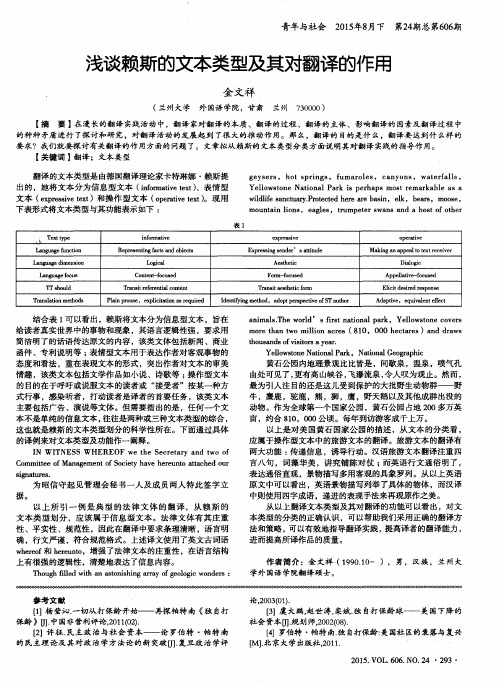
第2 4 期 总第6 0 6 期
浅谈赖斯的文本类型及其对翻译的作用
金 文祥
( 兰州大学 外国语 学院 ,甘肃 兰州 7 3 0 0 0 0)
【 摘
要】 在 漫长的翻译 实践 活动 中,翻译 家对翻 译的本质 、翻译的过程 、翻 译的主体 、影 响翻译的 因素及 翻译过程 中
的 种 种 矛 盾 进 行 了探 讨 和研 究 ,对 翻 译 活 动 的 发 展 起 到 了很 大 的推 动 作 用 。那 么 , 翻 译 的 目的 是 什 么 ,翻 译 要 达 到什 么样 的
青年与社会2015年8b下第24期总第606期浅谈赖斯的文本类型及其对翻译的作用金文祥兰州大学外国语学院甘肃兰州730000摘要在漫长的翻译实践活动中翻译家对翻译的本质翻译的过程翻译的主体影响翻译的因素及翻译过程中的种种矛盾进行了探讨和研究对翻译活动的发展起到了很大的推动作用
青年与社会
2 0 1 5 年8 B下
要求?我们就要探讨有 关翻译 的作 用方 面的 问题 了。文章拟从赖斯 的文本类型分类方面说 明其对翻译 实践的指导作用。
【 关键词 】 翻译;文本类型
翻译 的文本 类型是 由德 国翻译理论家卡特琳娜 ・ 赖斯 提
g e y s e r s ,h o t s pr i ng s ,f uma r o l e s ,c a n y o n s , wa t e r f a l l s,
Ye l l o ws t o n e Na t i o n a l P a r k i s p e r h a p s mo s t r e ma r k a b l e a s a wi l d l i  ̄s a n c t u a r y . P r o t e c t e d h e re a l e b a s i n, e l k,b e a r s ,mo o s e,
从奈达“功能对等”理论浅析信息功能文本的翻译

从奈达“功能对等”理论浅析信息文本的翻译第一章翻译任务介绍第一节文本内容及背景非文学翻译也可以笼统地称为应用型翻译。
文学翻译通常将原文放在首位,而非文学翻译则要求译者将主要信息剥离出原文,以传达信息或进行交流。
《卫报》、《大西洋月刊》、BBC新闻、ESPN体育新闻,英译汉5000字翻译材料全部为英语报刊类文章,涉及科学、文化、体育、经济等多个领域。
这些报刊在全世界范围内都有重大影响,读者主要是知识分子、专业人员。
在全球化的大背景下,随着我国经济、文化事业的发展和对外开放程度的不断加大,越来越多的单位有树立对外形象j与境外相关领域建立起交往关系的需要。
外宣材料的翻译应运而生,并得到空前发展。
(杜争鸣,2008)青岛国际海洋节宣传材料。
第二节文本类型及特点卡塔琳娜.赖斯(KatharinaReiss)是功能派的奠基人。
基于对等论,她提出了功能主义翻译批评理论——文本类型理论(Text-typology)。
赖斯依此将文本划分为三类:信息功能文本(informative),表情功能文本(expressive)币Fl操作功能(operative)文本。
此研究报告是研究生阶段翻译实践的分析总结,凶此包含了英译汉及汉译英两部分。
英译汉选取的是新闻报刊类文章,汉译英选取的是公文性应用文一公司制度文件。
两种文本都是赖斯笔下的“信息功能文本”,虽各有提点,但是同属非文学翻译,与文学翻译大有不同。
根据赖斯的理论,信息性文本具有如下特点:认知的(cognitive)、外延的(denotative)、表述的(representational)、理智的(intellectual)、指涉(referential)、描写的(descriptive)、和客观的(objective)。
此类文本的目的在于如实的传递信息。
(陈宏薇,2009)2.1英译汉文本新闻报刊按体裁可分为消息(newsstory)、特写(features)、新闻评论feditorials)等。
赖斯的文本类型论

E.g.: These statements are worth taking with a basketfull of salt.
这句话的with a basketfull是从with a grain of salt (半信半疑)变 过来的,将grain 换成basketfull, 表明程度大大增加。
文本翻译:译文应充分传达原文的指涉功能,文本中指涉的可能是现实的 或者虚拟的事物。
PPT模板下载:/moban/ 节日PPT模板:/jieri/ PPT背景图片:/beijing/ 优秀PPT下载:/xiazai/ Word教程: /word/ 资料下载:/ziliao/ 范文下载:/fanwen/ 教案下载:/jiaoan/
行业PPT模板:/hangye/ PPT素材下载:/sucai/ PPT图表下载:/tubiao/ PPT教程: /powerpoint/ Excel教程:/excel/ PPT课件下载:/kejian/ 试卷下载:/shiti/
行业PPT模板:/hangye/ PPT素材下载:/sucai/ PPT图表下载:/tubiao/ PPT教程: /powerpoint/ Excel教程:/excel/ PPT课件下载:/kejian/ 试卷下载:/shiti/
行业PPT模板:/hangye/ PPT素材下载:/sucai/ PPT图表下载:/tubiao/ PPT教程: /powerpoint/ Excel教程:/excel/ PPT课件下载:/kejian/ 试卷下载:/shiti/
PPT模板下载:/moban/ 节日PPT模板:/jieri/ PPT背景图片:/beijing/ 优秀PPT下载:/xiazai/ Word教程: /word/ 资料下载:/ziliao/ 范文下载:/fanwen/ 教案下载:/jiaoan/
目的论
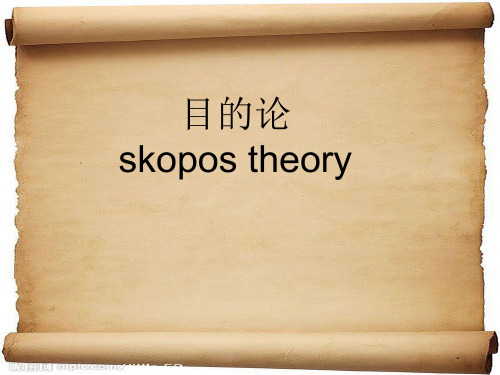
1971 年,在《翻译批评的可能性与限制》 ( Possibilities and Limitations in Translation Criticism) 首先提出要“把翻译行为所要达到的特殊目的”作为 翻译批评的新模式结构主义翻译研究打破了结构主义语义、句法的静态研究模式, 将 语言结构之外的要素列入了研究领域, 从文化、历史、意识形态、 译者目的等视角研究翻译, 认为翻译活动是多元、多向度的翻译研 究。虽然功能主义目的论的局限性使它不能成为具有普遍意义的综 合原则, 但在非文学语篇中, 如旅游宣传资料的翻译中是可以遵循的 原则。因为这类的语篇具有感染、劝诱的特殊社会功能。广告的目 就是促销, 增加客商的利润; 旅游宣传资料就是要让外国普通旅游者 读懂、看懂, 从而引起兴趣。如: 广告英语: 英文商标如Pampers ( 尿布) , Luxury ( 香皂) , Leopard( 汽车) 等, 中文商标如:好孩子、 童车 、舒尔美内衣和美的电器等, 普通词汇商标大多采用间接提醒 的方法来暗示商品的质量和功能, 消费者看到这些商标名称, 自然产 生积极联想, 从而激起购买欲望, 达到较好的商业效果。旅游英语: 旅游资料是一种大众化的通俗读物, 目的就是让普通游客读懂并喜 闻乐见, 从中获取相关的自然、地理、文化、风俗方面的知识。它 主要有两个功能, 一是传递信息, 二是引诱行动, 因此其语言表达必 须准确、通俗、明了、富有吸引力, 能雅俗共享。
连贯性法则(coherence rule)指的是译文 必须符合语内连贯(intratextual coherence) 的标准。所谓语内连贯是指译文必须能让接 受者理解,并在目的语文化以及使用译文的 交际环境中有意义。 忠实性法则(fidelity rule)指原文与译文间 应该存在语际连贯一致(intertextual coherence) 。语际连贯类似于通常所说的忠 实于原文,而忠实的程度和形式则由译文目 的和译者对原文的理解决定。
基于文本类型理论的翻译教材编写2011

142河 北 理 工 大 学 学 报(社会科学版)第11卷文章编号:1673–2804(2011)01-0142-04基于文本类型理论的翻译教材编写高 路(浙江理工大学 外国语学院,浙江 杭州310018)关键词:文本类型理论;翻译教材;文本意识;翻译策略;翻译评估摘 要:莱斯的文本类型理论以文本的功能和类型划分作为选择翻译策略和进行翻译评估的依据,对翻译教材编写具有重要启示。
编写基于该理论的新型翻译教材对于培养学生的文本意识,指导学生的翻译策略选择,以及辅助学生的翻译评估均具有重要的理论和实践意义。
中图分类号:H315.9文献标志码:A高等学校外语专业教学指导委员会指出,“21世纪的外语专业教材应该具备以下几个基本特征:(a)教学内容和语言能够反映快速变化的时代。
(b)要外理好专业知识、语言训练和相关学科知识之间的关系。
(c)教材不仅仅着眼于知识的传授,而要有助于学生的鉴赏批评能力、思维能力和创新能力的培养。
(d)教学内容有较强的实用性和针对性。
”[1]。
然而,目前我国翻译教材建设相对滞后于翻译学科的发展,高校英语专业本科使用的翻译教材大多在不同程度上受到传统语言学的影响,过多地关注于词句间的对等,缺乏具体的文本分析,使学生只能学到简单的词句转换技巧,难以培养学生的综合翻译能力,难以适应当今社会对实用性人才的迫切需求。
因此,笔者认为,将德国功能学派代表翻译家莱斯的文本类型理论应用于翻译教材编写,在编写过程中以文本为单位,注重培养学生的文本意识和文本类型分析能力,让学生从文本特征和文本功能的角度思考翻译策略、指导翻译评价,不仅能翻译教材更具实用性和针对性,还可以真正提高学生的鉴赏能力、批评能力、思维能力和创新能力,实现教学大纲提出的教学目标。
一 莱斯的文本类型理论捷克语言学家布勒(Karl Bühler)提出的语言功能“工具模式”在语言学界影响深远,他根据语言工具模式中的成分及其之间的关系,确认了语言的三种功能:信息功能(informative function)、表情功能(expressive function)和感召功能(appellative function)[2]。
Text Typology文本类型 赖斯
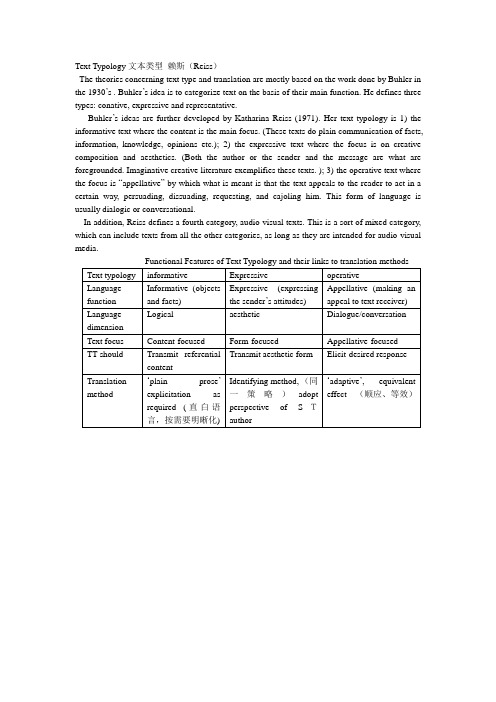
Text Typology文本类型赖斯(Reiss)The theories concerning text type and translation are mostly based on the work done by Buhler in the 1930‟s . Buhler‟s idea is to categorize text on the basis of their main function. He defines three types: conative, expressive and representative.Buhler‟s ideas are further developed by Katharina Reiss (1971). Her text typology is 1) the informative text where the content is the main focus. (These texts do plain communication of facts, information, knowledge, opinions etc.); 2) the expressive text where the focus is on creative composition and aesthetics. (Both the author or the sender and the message are what are foregrounded. Imaginative creative literature exemplifies these texts. ); 3) the operative text where the focus is “appellative” by which what is meant is that the text appeals to the reader to act in a certain way, persuading, dissuading, requesting, and cajoling him. This form of language is usually dialogic or conversational.In addition, Reiss defines a fourth category, audio-visual texts. This is a sort of mixed category, which can include texts from all the other categories, as long as they are intended for audio-visual media.。
赖斯的文本类型论 PPT

PPT模板下载: 节日PPT模板: PPT背景图片: 优秀PPT下载: Word教程: 资料下载:
Excel教程: PPT课件下载: 试卷下载:
批评
PPT模板下载: 节日PPT模板: PPT背景图片: 优秀PPT下载: Word教程: 资料下载:
范文下载:
教案下载:
行业PPT模板: PPT素材下载:
PPT图表下载: PPT教程:
Excel教程: PPT课件下载: 试卷下载:
文本类型的切分,太泾渭分明,在实际翻译过程中不能应对复
范文下载:
教案下载:
行业PPT模板: PPT素材下载:
PPT图表下载: PPT教程:
Excel教程: PPT课件下载: 试卷下载:
大家应该也有点累了,稍作休息
大 家 有 疑 问 的,可 以询问 和交流
翻译批评的功能范畴
Translation Criticism: The Potentials & Criticism 《翻译批评:潜力与制约》
➢将功能对等理论应用到翻译批评中,提出 比较合理的翻译批评观,以功能等值作为译 文质量评估标准。 ➢70年代初首先提出,等值的概念不应该只 停留在字、词、句的微观层面上,而应该涉 及文本(语篇层面)。
主要作品:
TranslaLeabharlann ion Criticism: The Potentials & Criticism 《翻译批评:潜力与制约》
Text Typology文本类型 赖斯

Text Typology文本类型赖斯(Reiss)The theories concerning text type and translation are mostly based on the work done by Buhler in the 1930‟s . Buhler‟s idea is to categorize text on the basis of their main function. He defines three types: conative, expressive and representative.Buhler‟s ideas are further developed by Katharina Reiss (1971). Her text typology is 1) the informative text where the content is the main focus. (These texts do plain communication of facts, information, knowledge, opinions etc.); 2) the expressive text where the focus is on creative composition and aesthetics. (Both the author or the sender and the message are what are foregrounded. Imaginative creative literature exemplifies these texts. ); 3) the operative text where the focus is “appellative” by which what is meant is that the text appeals to the reader to act in a certain way, persuading, dissuading, requesting, and cajoling him. This form of language is usually dialogic or conversational.In addition, Reiss defines a fourth category, audio-visual texts. This is a sort of mixed category, which can include texts from all the other categories, as long as they are intended for audio-visual media.。
reiss的翻译理论
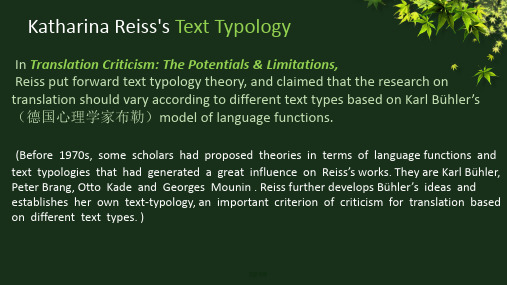
行业PPT模板:/hangye/ PPT素材下载:/sucai/ PPT图表下载:/tubiao/ PPT教程: /powerpoint/ Excel教程:/excel/ PPT课件下载:/kejian/ 试卷下载:/shiti/
三 、appeal-focused text 呼唤文本
The appeal-focused text includes advertising, publicity, preaching, polemic, propaganda, demagogy or satire.
The translation of appeal-focused texts aims to get a non-linguistic result
二、 form-focused text 表情文本
Reiss proposes that “form-focused texts are texts based on formal literary principles, and texts which express more than they state, where figures of speech and style serve to achieve an esthetic purpose” . Such texts basically are artistic literary works including literary prose such as essays, biographies and belles-lettres; imaginative prose such as short stories, novellas and romances, and poetry in all its forms
赖斯的文本类型和文本种类

赖斯的文本类型和文本种类赖斯是一种用于表示文本类型和文本种类的标准分类系统,它可以帮助我们更好地理解和识别不同类型的文本。
在赖斯系统中,文本类型指的是文本的一般类别,而文本种类则是具体的细分类别。
下面将详细介绍赖斯的文本类型和文本种类。
一、赖斯的文本类型1. 叙述性文本(Narrative Text):叙述性文本是用来叙述故事或事件的文本,通常包括情节、人物和背景描述等。
这种文本类型常见于小说、故事、传记等。
2. 说明性文本(Expository Text):说明性文本是用来解释和介绍事物的文本,目的是向读者提供相关信息和知识。
这种文本类型常见于科普文章、教科书、报告等。
3. 议论性文本(Argumentative Text):议论性文本是用来表达观点和论证的文本,通过论据和证据来支持作者的观点。
这种文本类型常见于辩论文章、评论、社论等。
4. 描述性文本(Descriptive Text):描述性文本是用来描述事物的特征和特点的文本,通过形象生动的语言描绘事物的外貌、感官等。
这种文本类型常见于旅游介绍、景点评论、产品说明等。
5. 诗歌性文本(Poetic Text):诗歌性文本是用来表达情感和美感的文本,通常使用韵律和修辞手法来创作。
这种文本类型常见于诗歌、歌词等。
二、赖斯的文本种类1. 小说(Novel):小说是一种长篇虚构故事的文本,通常由情节、人物、背景等构成。
它可以包括多种文本类型,如叙述性、说明性和议论性等。
2. 传记(Biography):传记是一种以真实人物的生平事迹为基础的文本,通过叙述和描述来展现人物的经历和成就。
它属于叙述性文本。
3. 科普文章(Popular Science Article):科普文章是一种用通俗易懂的语言来介绍科学知识和原理的文本,旨在普及科学知识。
它属于说明性文本。
4. 教科书(Textbook):教科书是一种用于教学的文本,通常包含知识点、练习题等内容,旨在传授知识和培养学生的能力。
Reiss莱斯文体分类
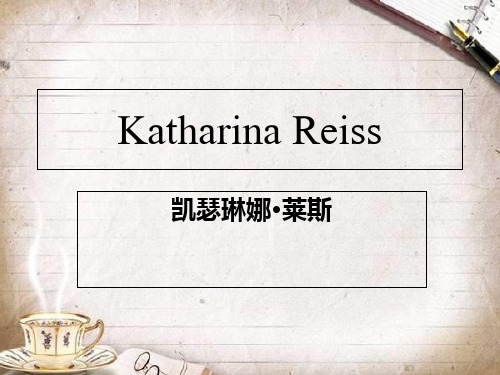
the multi-medial text type.
• The need for this arises from the fact that the translating material does not only consist of written texts, but also include verbal texts
• Eg.
• a,The particular frequency of words and phrases of evaluation (positive for the addresser or for the cause to which he has committed himself; negative for any obstacle to his commitment)
• At the point, the author distinguish the changes between "intentional" and "unintentional" changes affecting the translation.
Unintentional changes may arise from the different language structures as well as from differences in
• INTERLINGUAL TRANSLATION may be defined as a bilingual mediated process of communication, which ordinarily aims at the production of a TL [target language] text that is functionally equivalent to an SL text [source language].
文本类型理论与商务文本翻译

文本类型理论与商务文本翻译[摘要]德国翻译家赖斯和英国翻译家纽马克将文本分为表达型、信息型和呼唤型的文本类型理论简洁明确、易于操作,为非文学文本翻译提供切实可行的方法。
而商务文本种类繁多,具备不同语言特征。
因此翻译时应根据不同的文本类型,采取不同的翻译策略和方法,或采用语义翻译法贴近原文,或采用交际翻译法注重信息传递效果。
[关键词]文本类型理论;商务文本;语义翻译法;交际翻译法文本类型与翻译有着十分密切的联系,翻译者在从事翻译时必须有文本意识。
商务英语文本涵盖面较广,如合同、公函、商法、广告、产品说明书等,有着不同的语言特征。
翻译者必须熟悉英汉各种商务文本类型的语言特征,才能在英汉语言转换中顺应的语文本的需要,做到量体裁衣,具体情况具体分析,使的语文体与原语文体相适应。
一、关于文本类型理论较早提出文本类型(text typology)问题的是德国翻译学家赖斯。
[1]24-27赖斯在其著作《翻译批评:前景与局限》中提出翻译需要研究文本类型。
在她之前,布勒(Karl Buhler) 曾将语义功能分为三类:表达功能、信息功能、感染功能,建立了翻译类型学体系。
在借鉴了这三种功能分类的基础上,赖斯将文本分为三大类:内容为主文本,这种文本重文本的内容,主要反映客观现实,传递信息,所以该文本也被称为信息文本;形式为主文本,其内容通过艺术形式表现,这种文本实际就是指文学文本;感染为主文本,是指以感染为主要目的的文本,如广告、布告、宣传、营销等文本。
赖斯认为,信息文本翻译的首要目的是保证信息的正确,文学文本关心修辞结构的相应美学效果,而感染文本则要达到原文的目的。
英国翻译理论家彼特·纽马克(Peter Newmark)根据布勒的语言功能说,在赖斯的信息型、表达型、感染型三类文本基础上,重新将文本体裁分为表达型文本、信息型文本和呼唤型文本。
纽马克按体裁将严肃文学作品、官方文告、自传文学、私人书信等归为表达型文本;将自然科学、科技、工商经济、方面的读本、报告、文件、报刊文章、备忘录、会议记录等纳入信息型文本;将通告、说明书、公共宣传品、通俗作品等归为呼唤型文本。
赖斯文本类型

赖斯文本类型嘿,咱今儿就来唠唠赖斯文本类型这档子事儿。
你说啥是赖斯文本类型呢?就好比咱生活里的各种东西有不同的用处和特点一样,文本也有不同的类型呀!这赖斯文本类型呢,就是把文本分成了好几种。
比如说信息型文本,那就是专门给咱传递各种信息的,就像一个知识宝库,啥都有。
你想想,咱看的那些说明书、新闻报道,不就是为了让咱知道点儿啥嘛!这就跟咱找朋友打听事儿一样,得听清楚、弄明白。
还有表情型文本,这可有意思了,就像是一个人在抒发自己的情感呢!诗歌、散文啥的很多都属于这种。
读起来那叫一个有感觉,能让你跟着作者的喜怒哀乐走,就好像你也经历了那些事儿一样。
再说说操作型文本,这就像是一个指南,告诉你咋做事情。
像菜谱、操作手册,都是为了让咱能照着做,把事儿给干好。
那这赖斯文本类型有啥用呢?哎呀,用处可大了去了!就说咱读书吧,如果知道这是啥类型的文本,就能更好地理解它呀!信息型的,咱就着重去获取信息;表情型的,咱就好好感受那情感;操作型的,咱就跟着步骤一步一步来。
你看啊,要是你把一首诗歌当成信息型的去读,拼命想找具体的数据啥的,那不是白费劲儿嘛!反过来,要是把说明书当成诗歌去欣赏情感,那不是也不对路嘛!而且,了解了赖斯文本类型,咱写东西的时候也能更得心应手呀!想传达信息,就用信息型的写法;想表达情感,就用表情型的风格。
这就跟咱穿衣服似的,不同场合得穿合适的衣服,这才能得体呀!咱再想想,生活中好多地方都能用到这赖斯文本类型的知识呢!比如说老师上课,不就得根据不同的内容选择不同的表达方式嘛!要是讲个历史事件,那就是信息型为主;要是讲诗歌赏析,那就是表情型啦!还有啊,咱工作的时候,写报告、做方案,也得清楚是哪种类型,这样才能让别人看得明白、用得顺手呀!总之呢,这赖斯文本类型就像是一个隐藏的宝藏,等你去发现、去利用。
你说咱要是把这玩意儿弄明白了,那读书、写作、工作啥的,不都能更上一层楼嘛!你还别不信,自己好好琢磨琢磨,是不是这么个理儿!。
- 1、下载文档前请自行甄别文档内容的完整性,平台不提供额外的编辑、内容补充、找答案等附加服务。
- 2、"仅部分预览"的文档,不可在线预览部分如存在完整性等问题,可反馈申请退款(可完整预览的文档不适用该条件!)。
- 3、如文档侵犯您的权益,请联系客服反馈,我们会尽快为您处理(人工客服工作时间:9:00-18:30)。
Text Typology文本类型赖斯(Reiss)
The theories concerning text type and translation are mostly based on the work done by Buhler in the 1930’s . Buhler’s idea is to categorize text on the basis of their main function. He defines three types: conative, expressive and representative.
Buhler’s ideas are further developed by Katharina Reiss (1971). Her text typology is 1) the informative text where the content is the main focus. (These texts do plain communication of facts, information, knowledge, opinions etc.); 2) the expressive text where the focus is on creative composition and aesthetics. (Both the author or the sender and the message are what are foregrounded. Imaginative creative literature exemplifies these texts. ); 3) the operative text where the focus is “appellative” by which what is meant is that the text appeals to the reader to act in a certain way, persuading, dissuading, requesting, and cajoling him. This form of language is usually dialogic or conversational.
In addition, Reiss defines a fourth category, audio-visual texts. This is a sort of mixed category, which can include texts from all the other categories, as long as they are intended for audio-visual media.。
